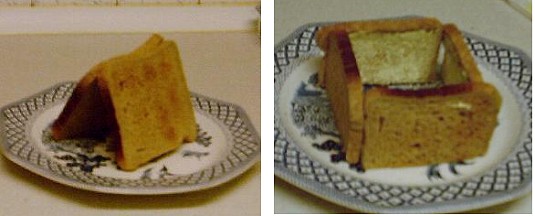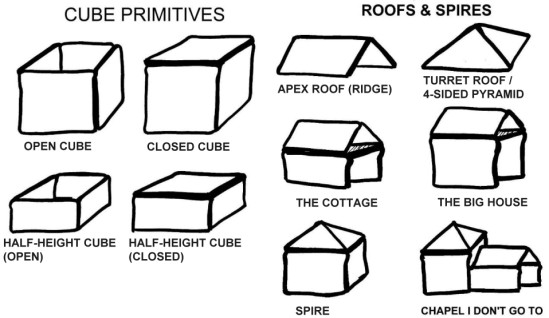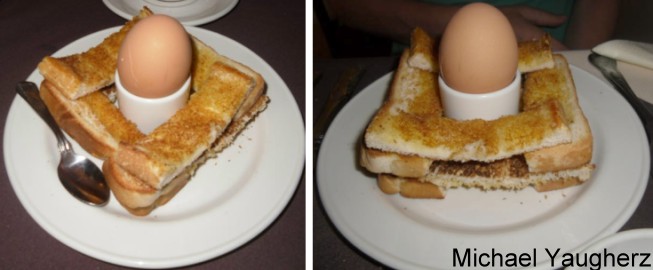|
Affiliated to the Toast Leaners' Club |
THE BARAGAMI HOME PAGE
|
Affiliated to the Toast Leaners' Club |

WHAT IS BARAGAMI?
Baragami is the ancient Welsh decorative art of "toast arranging".
Bara (noun, Welsh language) "bread"
Gami: derived from origami, the art of paper-folding or paper-sculpture
First documented in Aberystwyth, Wales, baragami involves the presentation of toast in intricate and preferably topical arrangements. Just as haiku should have a reference to the seasons, a skillful baragami endeavours to make reference to current affairs although there are a number of classical toast arrangements. An example of the "topical" aspect of baragami would be the classical "falling house" arrangement, popular after the Word Trade Center disaster. Alternatively, a concept or emotion may form the basis of the pattern.
The actual date of origin of this nearly extinct art, prior to its rediscovery in Aberystwyth, has not been authenticated, having been lost in the mists of Plynlimon Fawr. Historians have proven that toasting bread was a common activity in Roman times: the Latin root of the word toast being "tostum", which means to scorch or burn. Early cave markings in Ogof Pant y Llyn, Dyfed illustrate that early Welsh nomads prolonged the life of bread by toasting it. Simply impaling a lump of bread on a forked stick or extended fork in front of an open fire permitted a few basic designs, but was not really conducive to the flowering of baragami as an elaborate art form. The heyday of baragami required the invention of the electric toaster (Crompton & Co, England, 1893) and the development of the machine that sliced and wrapped bread (Frederick Rohwedder, Chillicothe, Missouri, 1928) to produce the larger quantities of toast required. Early toasteddfods relied on the wives and daughters of baragamists to hand-slice large quantities of bread and toast it on racks suspended in front of a fire. The standard square loaf removed the need to trim irregular slices to a workable standard shape and size.
In spite of better slicers and toasters and even home breadmakers that allow the production of interesting textures and colours, baragami is in decline and is now practised by only a few enthusiasts. Practitioners can be found among Welsh ex-pats worldwide, but with fewer youngsters taking up the art, their numbers are dwindling. A Welsh heritage organisation are considering teaching baragami in schools alongside the Welsh language and urge the development of a computer package allowing virtual baragami, perhaps in a worldwide online community.
On this page I will try to capture the essence of baragami in words and pictures (as they become available).
HOW DOES BARAGAMI DIFFER FROM TOAST SCULPTURE?
Baragami aims to create designs with the minimum use of cuts. It may be necessary to remove crusts or to use slices from different loaves to attain different sized pieces, but fancy bread-trimming such as curves, zig-zags, crenellations etc are frowned upon. In toast sculpture, pieces of toast are cut to the desired shape (frequently irregular shapes) and size like pieces of a 3D jigsaw. In baragami, the practitioner aims to use simple, regularly shaped pieces - triangles, rectangles, squares. There are other shapes e.g. lozenge, kite, but a baragamist considers there to be more skill in working within the constraints of the slice than carving slices to meet particular needs.
In toast sculpture, the use of decorative items such as flags or cocktail umbrellas are permitted. Not so in baragami - the whole effect must be created by toast alone (and maybe a small smear of butter or jam).
In toast sculpture, props such as cocktail sticks are often used to hold a sculpture together. In baragami, the pieces of toast must be balanced against each other although the use of a "cement" such as butter or marmalade is grudgingly permitted since these items are so closely associated with toast.
In toast sculpture, the design is usually explicit - a castle has twiddly bits carved on the towers and curtain walls and arrow slits; a church has arched windows cut into the sides. Any idiot can understand a toast sculpture. In baragami, however, the viewer is given an "idea of the design" rather than it being given to him on a plate, as it were. What is "not there" is just as important as what is there. By working within the constraints of simple regular shapes, balance and no props, baragami presents the concept - it can represent a static item, a moving object or even represent a concept such as "motion" or "harmony".
BARAGAMI FOR BEGINNERS
TOAST
Baragami toast must be square. Imperfections will occur and experienced baragamists will work with these. Domed slices, cottage loaves etc are not suitable for baragami. To make some of the designs you will require several loaves with slightly different sized slices.
CUTTING THE TOAST
Only two types of cut are permitted. The first is the "Diagonal Cut" dividing the toast diagonally into two right-angle triangles (Major triangles). Two Diagonal Cuts will create four right-angle triangles (Minor Triangles). Each triangle may be cut into smaller right-angle triangles by cutting from halfway along the hypotenuse to the triangle apex.
The second cut is the "Straight Cut" from side to side of the toast to create two rectangles of equal size (Major Rectangles). Each rectangle may be further subdivided in similar manner into Minor Rectangles.
The slices should not be shaped or carved in any other way. In traditional baragami, only right angle triangles are permissible. Some practitioners of contemporary baragami also work with 30 degree triangles made by subdividing a single right angle triangle into thirds (cutting from apex to points one third of the way along the hypotenuse).
ORNAMENTAL CUTS
Some baragami enthusiasts like to cut patterns in the toast e.g. crenellations, windows etc. In traditional baragami this is frowned upon as the final sculpture is intended to be symbolic.
Baragami purists also frown upon edge cutting to create perfectly straight edges by paring away slight imperfections in the crust of the bread. Traditional baragami dictates that the imperfections be worked with and overcome rather than artificially removed.
FLAT BARAGAMI DESIGNS

1. THE BASIC FLAT PATTERNS
The "Simple Fan " or "Hand of Cards"
One of the most basic baragami designs is a spread of toast in a "fan" or "hand of cards".
This can be done with toast sliced into triangles (hypotenuse forms the "rays" of the fan) or into rectangles (the long sides form the "rays" of the fan).
The "Circular Fan"
In this design, based on the Simple Fan, the toast forms a complete circle with the final slice tucked under the first slice so that the beginning and the end cannot be determined. It is considered a debasement of the art of baragami to place curls of butter in the centre of the Circular Fan.
The "Traditional Crop Circle"
The oldest known baragami design (see photo).
"Partial Jubilee" or "Maltese Cross"
A simple design popular on the Royal occasions.

2. COMPLEX FLAT BARAGAMI DESIGNS
The "Chrysanthemum" or "Sunflower"
A "flat design" comprising triangles of toast (of decreasing size), preferably alternating between white and wholemeal, arranged in a flower-burst. The larger triangles are made by cutting the toast diagonally. "Minor triangles" are made by cutting a "major triangle" from apex to halfway along the hypotenuse. Although frowned upon by traditionalists, each triangle may be further subdivided, long petals being formed by cutting a triangle into three parts (each being from apex to points one third of way along the hypotenuse). To preserve the symmetry and harmony of the arrangement, followers of traditional baragami avoid "thirds", obtaining the flower effect through painstaking arrangement of the petals.
THREE DIMENSIONAL BARAGAMI DESIGNS
1. THE BASIC THREE DIMENSIONAL PATTERNS

The "Apex Roof" or "Ridge"
Two rectangles of toast with the upper long sides leaning against each other form the "Apex Roof" or "Ridge".
The "Turret Roof" or "Pyramid"
Four triangles of toast, placed in a square and leaning inwards. The hypotenuses form the base and the apexes touch to form a four sided pyramid. It is necessary to pinch or crease the toast bread at the centre of the hypotenuse so that the pyramid does not fall flat (to form what seamstresses call "a dart").
The "Cube"
Four slices of toast placed on edge in a square to form 4 sides of a cube. The "Open Cube" has no top. The "Closed Cube" has a fifth slice placed as a lid on the four uprights.
The "Half-Height Cube"
As for the "Cube", but using four rectangular halves of toast, placed with long edges forming the bottom and the top. Again, it may be either "open" or "closed" (with a full slice of toast forming the lid)
The "Tower"
The "Tower" is simply a stack of full-height or half-height cubes. It may be straight or twisted (by rotating each successive layer). Butter or marmalade may be used to mortar the layers.
The "Cottage"
An open-ended design. Two rectangular halves of toast form the "front" and "back" walls of the cottage. A third rectangle forms the lid (required for stability). A "Ridge" forms the Cottage roof. Traditionally this item is burnt not eaten and its immolation is accompanied by "Come home to a real fire - buy a holiday cottage in Wales".
The "Big House"
The basic design is the same as the cottage except that the walls are full height and made from whole slices of toast.

2. COMPLEX THREE DIMENSIONAL BARAGAMI DESIGNS The "Spire"
A full height "Closed Cube" or a "Tower" forms the walls of the spire. The arrangement is completed by a "Turret Roof" balanced on the top. A discreet amount of marmalade may be used to cement the arrangement.
The "Chapel I Don't Attend" ("Chapel I Don't Go To")
A traditional Welsh motif, but surprisingly simple to construct. A full height spire or a Tower forms the chapel spire. A "Cottage" placed next to the spire forms the nave.

The "Castle"
This is an extension of the Chapel I Don't Attend. The four castle towers are all baragami Spires. The four castle walls are all baragami Cottages. A double-height Spire (A spire placed atop a Closed Cube may be places at the centre of the Castle.
The "Falling House"
A photo of this intricate design is eagerly awaiting from a leading Welsh Baragamist located in Aberystwyth.
The Cell
A variation on the traditional "four-sided open stack". The addition of a captive boiled egg transforms this basic design into the representation of a cell. Such a design has historically been used as a veiled threat to the recipient.

ARE YOU A BARAGAMIST?
If you are a practitioner of traditional baragami (no "toast sculpture" please) and have a design to contribute, please email it to sarah.hartwell[at]blueyonder.co.uk
The Baragami Home Page is brought to you by Sarah Hotdesking & Andrew Robert Breen
|
Affiliated to the Toast Leaners' Club |
Return to Dragonqueen's Humor & Story Site You are visitor number: